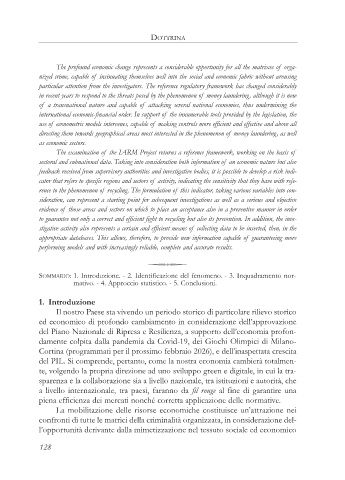Page 130 - Rassegna 2024-3
P. 130
DOTTRINA
The profound economic change represents a considerable opportunity for all the matrixes of orga-
nized crime, capable of insinuating themselves well into the social and economic fabric without arousing
particular attention from the investigators. The reference regulatory framework has changed considerably
in recent years to respond to the threats posed by the phenomenon of money laundering, although it is now
of a transnational nature and capable of attacking several national economies, thus undermining the
international economic-financial order. In support of the innumerable tools provided by the legislation, the
use of econometric models intervenes, capable of making controls more efficient and effective and above all
directing them towards geographical areas most interested in the phenomenon of money laundering, as well
as economic sectors.
The examination of the IARM Project returns a reference framework, working on the basis of
sectoral and subnational data. Taking into consideration both information of an economic nature but also
feedback received from supervisory authorities and investigative bodies, it is possible to develop a risk indi-
cator that refers to specific regions and sectors of activity, indicating the sensitivity that they have with refe-
rence to the phenomenon of recycling. The formulation of this indicator, taking various variables into con-
sideration, can represent a starting point for subsequent investigations as well as a serious and objective
evidence of those areas and sectors on which to place an acceptance also in a preventive manner in order
to guarantee not only a correct and efficient fight to recycling but also its prevention. In addition, the inve-
stigative activity also represents a certain and efficient means of collecting data to be inserted, then, in the
appropriate databases. This allows, therefore, to provide new information capable of guaranteeing more
performing models and with increasingly reliable, complete and accurate results.
!
SOMMARIO: 1. Introduzione. - 2. Identificazione del fenomeno. - 3. Inquadramento nor-
mativo. - 4. Approccio statistico. - 5. Conclusioni.
1. Introduzione
Il nostro Paese sta vivendo un periodo storico di particolare rilievo storico
ed economico di profondo cambiamento in considerazione dell’approvazione
del Piano Nazionale di Ripresa e Resilienza, a supporto dell’economia profon-
damente colpita dalla pandemia da Covid-19, dei Giochi Olimpici di Milano-
Cortina (programmati per il prossimo febbraio 2026), e dell’inaspettata crescita
del PIL. Si comprende, pertanto, come la nostra economia cambierà totalmen-
te, volgendo la propria direzione ad uno sviluppo green e digitale, in cui la tra-
sparenza e la collaborazione sia a livello nazionale, tra istituzioni e autorità, che
a livello internazionale, tra paesi, faranno da fil rouge al fine di garantire una
piena efficienza dei mercati nonché corretta applicazione delle normative.
La mobilitazione delle risorse economiche costituisce un’attrazione nei
confronti di tutte le matrici della criminalità organizzata, in considerazione del-
l’opportunità derivante dalla mimetizzazione nel tessuto sociale ed economico
128

